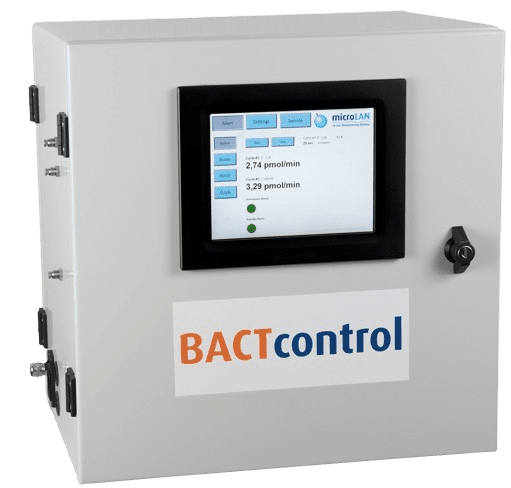
BACTcontrol
Description
Featuring a compact design, the BACTcontrol delivers rapid results within 1-2 hours, positioning itself as an essential tool for ensuring water safety and quality. With its efficient enzymatic analysis, this system stands as a reliable and indispensable instrument for continuous online monitoring of microbiological contamination to monitor E-coli, Coliforms, Enterococci and total bacterial activity in water
Advantages
- Monitoring of enzymatic activity and concentration up to 2 parameters: E-coli, Coliforms, Total bacterial activity, Enterococci.
- 2 ways of measurement possible.
- Automatic cleaning function.
- Fast measurement frequencies: 1 H30.
- Analog output (4-20 mA), Modbus TCP/Serial, 2 Relay outputs.
Assets
Measurement of bacterial activity E-coli, Coliforms, Enterococci, Total bacteria
Similar products
Why trust AQUALABO?
AQUALABO, a French company, offers a combination of experience, innovation, international presence, adaptability, and ecological commitment, making it a trusted partner for water quality control.
FAQ BACTcontrol
Can cleaning cycles be performed automatically on the BACTcontrol?
The BACTcontrol analyzer offers an automatic cleaning feature that can be configured via a menu. This cleaning cycle incorporates a specific concentrated cleaning solution and heating to increase the efficiency of the cleaning process. This procedure thoroughly cleans the analyzer's internal circuit, the bacteria capturing filter, and the measuring chamber. Incorporating this feature demonstrates our commitment to maintenance and operational efficiency which contributes to the on-going reliability of the device.
How do you store the reagents used in the BACTcontrol?
Clear instructions on how and how long to store reagents used in the BACTcontrol bacteria analyzer are given in the user manual. Since storage conditions may differ from usage conditions, it is strongly recommended that you refer to the user manual to avoid any alteration of the reagents. In general, once opened, reagents should be used within three months, while the recommended shelf life for unopened reagents is one year. Diligence in managing reagents will ensure optimal efficiency of the BACTcontrol analyzer while guaranteeing reliable results.
What quantity of reagents is consumed by the BACTcontrol?
The amount of reagent used depends on the type of bacteria to be detected, the frequency of measurements and the specific application, whether for drinking water, surface water, wastewater or reuse. To check if there is any E-coli bacteria in drinking water for example, the BACTcontrol analyzer will require 250 µL of reagent per measurement cycle. On the other hand, for a warning station monitoring surface water, the reagent consumption per measurement cycle will be 60 µL.
How does a measurement cycle work?
The BACTcontrol determines the concentration of E. coli, coliforms and total activity from specific enzymes in these bacteria. Each enzyme has its optimal level, requiring separate measurements. The sample enters the reaction chamber, concentrated in a ceramic filter, and is heated according to the enzyme to be analyzed. The user adjusts the volume to be filtered and pumped. Reagents are added to the tank, and incubation starts. The photodiode measures fluorescence due to enzyme activity, converted into bacterial population per 100 ml of sample. Enzymes, essential to metabolic processes, are selective and catalytic. The enzymatic activity, measured in picomole per minute, indicates the presence of bacteria. Alkaline phosphatase and beta-galactosidase, activated by specific reagents, are used to detect coliforms and E. coli. This technique, sensitive to low phosphate concentrations, is a warning system for drinking water quality. The fluorescence emitted during enzymatic hydrolysis helps measure enzyme activity.
